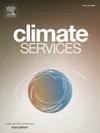埃塞俄比亚南部小农对气候变化的认知和适应策略:混合方法方法
IF 4
3区 环境科学与生态学
Q2 ENVIRONMENTAL SCIENCES
引用次数: 0
摘要
这项研究的目的是评估埃塞俄比亚南部Karat Zuria地区农民对气候变化的认知和适应情况。采用多元概率模型和描述性统计对339个样本家庭收集的横截面数据进行评估。在Karat Zuria接受调查的农民大多认为气候变化的影响正在加剧,包括不可预测的降雨、与热有关的作物和动物疾病、杂草肆虐加剧、气温上升、雨季缩短以及干旱/水资源短缺加剧。46.4%、72.5%、63.4%、88.9%、85.6%、51.0%、88.9%的小农对气候变化的适应策略分别是:小灌溉、农林复合、改种、水土保持、种植不同类型的植物、种植不同的作物品种、使用改良饲料作物和干草作为牲畜饲料。多变量probit模型结果显示,影响农户选择不同气候变化适应策略的主要因素是性别、年龄、气候变化知识、农场收入、家庭拥有的动物数量和规模、农场规模、信贷使用情况、农场与居住地的距离、干旱频率和作物损失经历。为了改善Karat Zuria的气候变化适应,政策制定者应该把重点放在解决信贷获取、农业知识和资源管理问题的有针对性的干预措施上,同时考虑农民的独特需求和情况。实际意义下面列出的图片都是在研究现场工作完成时拍摄的。图1和图6显示了用于收集水和适应气候变化的河流、泉水和灌溉水源。通过对关键信息提供方的访谈和实地观察,研究区域正在使用BH140玉米、DZ-CE37 teff、humara-1芝麻、绿豆、普通豆、Gubeye、Asnakech和Berhane等早熟作物品种作为替代适应技术(见图7-17)。由于水土保持技术降低了洪水的风险,提高了土壤湿度和有机质的保持性,因此,尤其是追踪技术,是应对气候变化的一种众所周知的方法。在农林业选择方面,研究区域的农民种植饲料植物,并在附近广泛使用的农林业技术包括土着的Oybata (Terminalia browine)和鸽豆(Cajanus cajan)。为了缓解动物饲料的短缺,农民经常在他们的田地周围种植本地饲料(Kanda),罗氏草(Chloris gayana)和象草(Pennisetum purpureum)。另一方面,研究地区的农民经常在干旱时期给他们的动物喂食农业剩余物并收获金合欢豆荚,作为对气候变化的一种适应。本文章由计算机程序翻译,如有差异,请以英文原文为准。
Smallholder Farmers’ perceptions of climate change and adaptation strategies in Southern Ethiopia: Mixed method approach
The study objective is to assess farmers’ perception and adaptation to climate change in the Karat Zuria district, Southern Ethiopia. Multivariate probit models and descriptive statistics were used to evaluate cross-sectional data collected from 339 sample households. Surveyed farmers in Karat Zuria largely perceive increasing climate change impacts, including unpredictable rainfall, heat-related crop and animal diseases, intensified weed infestations, rising temperatures, shorter rainy seasons, and worsening droughts/water shortages. 46.4%, 72.5%, 63.4%, 88.9%, 85.6%, 51.0%, and 88.9% of the smallholder farmers’ adaptation strategies to climate change are small-scale irrigation, agro-forestry, changing planting dates, soil and water conservation, growing different types of plants, growing different crop varieties, and using improved fodder crops and hay for livestock feed. The results of the multivariate probit model revealed that the main factors influencing households’ decisions to choose different adaptation strategies for coping with climate change are sex, age, knowledge of climate change, farm income, the number and size of animals owned by the household, the size of the farm, the use of credit, the distance between the farm and the residence, the frequency of drought, and experience of crop loss. To improve climate change adaptation in Karat Zuria, policymakers should focus on tailored interventions that address credit access, agricultural knowledge, and resource management, considering farmers’ unique needs and circumstances.
Practical implications
The images listed below were all taken when the study’s fieldwork was being done. Images 1 and 6 show rivers, springs, and irrigation water sources that are utilized to gather water and adapt to climate change.
As a consequence of key informant interviews and field observations, early maturing crop varieties such as BH140 maize, DZ-CE37 teff, humara-1 sesame, Mung bean, common bean, Gubeye, Asnakech, and Berhane are being used as alternative sorts of adaptation techniques in the research region (See photos 7–17).
Since they lessen the risk of flooding and improve soil moisture and organic matter retention, soil and water conservation techniques, notably tracing, are a well-known approach for dealing with climate change. Regarding the agroforestry option, farmers in the study region cultivate fodder plants and widely utilized agroforestry techniques in the neighborhood include the indigenous Oybata (Terminalia browine) and pigeam pea (Cajanus cajan).
In order to alleviate the shortage of animal feed, farmers frequently plant indigenous forage (Kanda), Rhodes grass (Chloris gayana), and elephant grass (Pennisetum purpureum) around their fields. On the other hand, farmers in the study area frequently feed their animals agricultural leftovers and harvest acacia pods during times of drought as a kind of adaptation to climate change.
求助全文
通过发布文献求助,成功后即可免费获取论文全文。
去求助
来源期刊

Climate Services
Multiple-
CiteScore
5.30
自引率
15.60%
发文量
62
期刊介绍:
The journal Climate Services publishes research with a focus on science-based and user-specific climate information underpinning climate services, ultimately to assist society to adapt to climate change. Climate Services brings science and practice closer together. The journal addresses both researchers in the field of climate service research, and stakeholders and practitioners interested in or already applying climate services. It serves as a means of communication, dialogue and exchange between researchers and stakeholders. Climate services pioneers novel research areas that directly refer to how climate information can be applied in methodologies and tools for adaptation to climate change. It publishes best practice examples, case studies as well as theories, methods and data analysis with a clear connection to climate services. The focus of the published work is often multi-disciplinary, case-specific, tailored to specific sectors and strongly application-oriented. To offer a suitable outlet for such studies, Climate Services journal introduced a new section in the research article type. The research article contains a classical scientific part as well as a section with easily understandable practical implications for policy makers and practitioners. The journal''s focus is on the use and usability of climate information for adaptation purposes underpinning climate services.
 求助内容:
求助内容: 应助结果提醒方式:
应助结果提醒方式:


